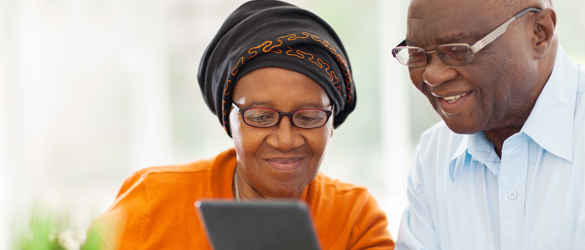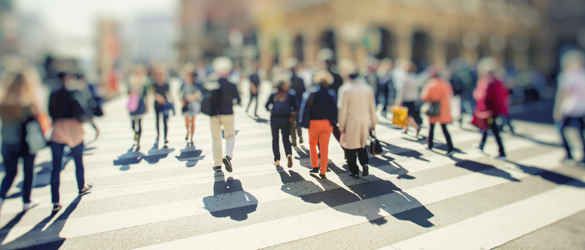
Shopping
Shopping is one of life's necessities; many people find it enjoyable. Macular disease can make shopping daunting and difficult. But with a few changes, you can still go out shopping should you wish to.
The way that we shop has changed. We can now get most of our essentials from large supermarkets delivered to our door.
If you want to go out to shop, here are some tips which might help:
- Think about the items that you want to buy and where you will get them.
- Consider a quieter time of day to go out so it's easier to move around.
- Visiting out of town retail parks can be less busy and easier to navigate.
- Creating a shopping list has become easier with today's technology. You can create a shopping list on your smart phone or tell your smart speaker to create a list, which you can then access on your smart phone.
- You could take the traditional route and use pen and paper in the size font you find easiest to read.
When you get to the shops
Depending on how you get to the shops, whether on public transport or by car, think about the best route around the area. This helps to reduce walking in busy areas unnecessarily. You might also want to use your symbol cane, so other shoppers are aware of your sight loss. Shop assistants will see your symbol cane and may offer help.
If you have a Blue Badge Parking Permit you are able to park closer to the shops or in accessible parking bays. To find out if you are entitled to a Blue Badge, please read our Registrating as sight impaired page.
You may want to visit shops that you are already familiar with. Members of staff in the shop are more likely to recognise you and offer help. The more you use familiar shops, the more you will learn your way around and where the items you want to buy are located.
Don't be afraid to ask for help from the shop assistants - that is what they are there for.
Technology that might help
Shopping with a friend or family member is helpful as they can support you in finding items you would like to buy, checking sizes and colours of clothes for example. If you prefer to shop on your own, taking some technology with you can help, such as:
- Your magnifier
- Barcode reader
- Hand held digital magnifier
There are also apps on your smart phone that can magnify and read barcodes.
For more information on the technology that is available, please see our Using Technology webpage.
Paying
There are various ways to pay for your shopping, depending on personal choice and the shop that you are in.
- Cash is seen as the easiest way to pay for shopping but there are some things to consider:
- All banks notes feel the same and are roughly the same size, so consider only using £10 and £5 notes.
- Try to avoid carrying too many coins as it can be difficult to identify the coins you need.
- There are devices available to help you find the right money. More information is available on our Daily Living page
- Chip & Pin: pay using either your debit or credit card. The card is placed into the machine and you enter your pin number to make a purchase. On the number pad of the card machine there is a raised dot on the number 5. This will help you navigate the buttons to enter your pin number.
- Chip & Sign: if you struggle with entering your PIN number, some banks issue Chip & Sign cards. (Be aware that this will turn off your PIN number and you will not be able to use some banks' cashpoints).
- Contactless payments: debit and credit cards have the ability to make contactless payments. Hold you card near the machine to make a payment of up to £45. If your purchase is above the £45 limit, consider splitting the payment in two. You can keep an eye on the money you are spending via online banking or using a banking app.
- You can also now save your card details to your smart phone or tablet, so you can make contactless payments using your device. You complete the transaction using your finger print, facial recognition or your device PIN number. It's even more secure than using your debit or credit card.
- With some online shopping you are able to use the card details saved on your phone/tablet to make the purchase.
You can ask your bank for an accessible debit or credit card which has a large arrow and a small notch on the end. This helps you to tell which way to put the card into a card machine. The card numbers are black on a white background, so the number can be read using a hand-held magnifier or CCTV magnifier.
Online Shopping
Many people with sight loss prefer to do their shopping online. Most retailers' websites and apps are very accessible. Some even have websites set up for people with sight loss. This includes retailers such as NEXT and Tesco.
- Major retailer apps are available to download on your smart phone, tablet or through a 'skill' on your smart speaker. The majority of them are easy to use and work well with speech and magnification software.
- Banking online is also a good way of keeping up to date with your finances. Their websites and apps are easy to access with both magnifications and speech software. Looking after your own bank account maintains independence and increases confidence in controlling your own money.
- There are online department stores such as Amazon which have comprehensive descriptions of their items. The descriptions are effective in increasing choice and can highlight deals that you may not have been aware of. These websites and apps work well with screen readers and magnification software.
Shopping and banking online is safe and secure. Remember don't share your passwords or login details with anyone else.
Want to know more about how you can make shopping easier?
Call the Macular Society Helpline on 0300 3030 111 or email help@macularsociety.org
Using technology
There are many adaptations to technology to help you navigating the increasingly technology filled world.
Out and about
Live confidently with our practical guides to getting out and about, from traveling and transport to eating out and shopping.
Get the latest news and advice from the Macular Society
To hear about life-changing research, treatments and tips for living with sight loss, subscribe to our monthly enewsletter today. Together we can Beat Macular Disease.
Sign up to our free email newsletter



